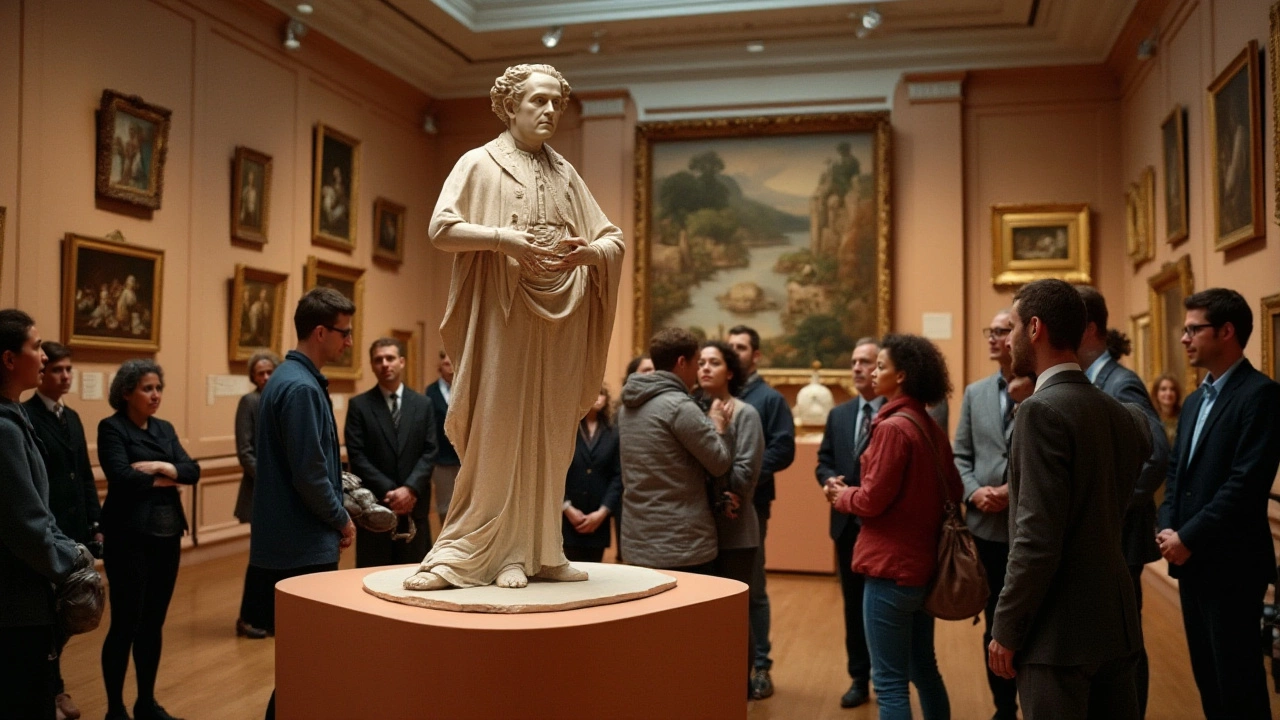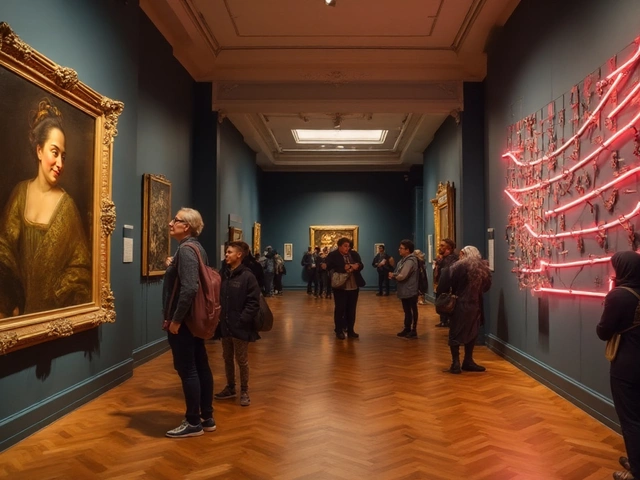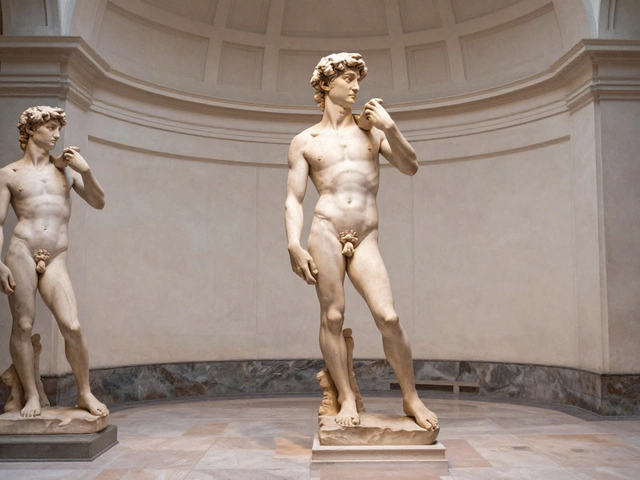In the realm of art, realistic sculptures stand out for their lifelike appearance and intricate details. Known for capturing the essence of their subjects with incredible precision, these sculptures push the boundaries of what is perceived as real versus artifice.
Imagine walking into a gallery and feeling the gaze of a sculpture follow you, or noticing the veins and skin texture that seem too authentic to be crafted by hand. Hyper-realistic sculptures have this remarkable power to mesmerize and challenge your perception.
These works of art often make you question the limitations of human craftsmanship and the potential of art to evoke emotions akin to real-life experiences. Join me as we delve into the fascinating world of hyper-realistic sculptures, exploring their origins, techniques, and the artists who breathe life into their creations.
- Understanding Hyper-Realism
- Historical Evolution of Realistic Sculpture
- Techniques and Materials
- Prominent Artists in Hyper-Realism
- Future of Realistic Sculpture
Understanding Hyper-Realism
At a glance, realistic sculptures often seem to exist on the border of illusion and reality, making them a powerful facet of contemporary art. Often described as an art form that achieves a level of realism so precise that it mirrors life itself, hyper-realism goes beyond the mere lifelike representation seen in traditional realism. This interesting movement emphasizes an all-encompassing, detailed depiction of the human figure, often leading the viewer to question whether what they see is an artifice or a living person placed on display.
Hyper-realism as an art movement began taking form in the early 21st century, although its roots can be traced back to the Post-World War II era works of Photorealism. Unlike its predecessor, which primarily focused on painting, hyper-realistic artists utilize a variety of mediums such as resin, silicone, and even human hair to capture a more dynamic sense of reality. Human skin with minute pores, expressive facial wrinkles, glassy eyes with veins—you name it; these elements of life find their way onto the sculptures with painstaking precision, transforming them into captivating characters frozen in time.
"Hyper-realism allows us as artists to create not only an object but an experience." - Jonathan Owen
Creating such experienced pieces requires remarkable skill and commitment, along with an artist's deepened understanding of anatomy and the optical perception of reality. Artists dive into a complex process where imagination and reality intermingle to form striking pieces that can momentarily deceive the senses. Indeed, the meticulousness also reflects in the time investment typical for these works, with projects often demanding several months or even years of unwavering focus to attain technical perfection. The uncanny resemblance to the real world isn't by mere accident; it is a deliberate and intensified study translating into visual poetry.
Interestingly, the growing accessibility of technology plays a profound role in developing the hyper-realistic movement. 3D printing, laser scanning, and other technological advancements are pivotal in transforming conceptualization into reality, affording artists tools to surpass traditional boundaries. Despite these technological aids, the innate craftsmanship remains at the heart of the art form, where the individual touch of an artist imbues life within inanimate objects. Thus, hyper-realism is not just a spectacle of what technology can achieve with human input but a testament to the brilliance of individual creativity.
Historical Evolution of Realistic Sculpture
The story of realistic sculpture, or hyper-realism art as it is often known, traces its roots back to ancient civilizations. From the Greeks to the Romans, the pursuit of capturing human likeness started millennia ago. Greek sculptors like Phidias were renowned for their dedication to representing the human body in idealized forms. They practiced a style known as Classical Realism, which was less about sheer accuracy and more about celebrating the human form.
Roman artists built on these techniques, but shifted the focus to capturing the individual’s persona. Realism took a more pronounced turn in the Renaissance. Artists such as Michelangelo and Donatello laid a foundation that would influence countless others with their meticulous attention to detail. Michelangelo's David is a classic example of this shift towards realism. This period marked a significant advancement in the techniques used to create more lifelike textures and anatomical detail.
Fast forward to the 19th century, the advent of photography began influencing artists to achieve even greater realism in their works. It was in response to this, in the late 20th and early 21st centuries, that hyper-realism art truly found its ground. Artists like Ron Mueck and Carole A. Feuerman are credited with pushing the boundaries beyond traditional realism into the realm of hyper-realism. Their works often challenge perceptions by reproducing minute details like pores and reflections of light on skin, creating a sculpture so lifelike it could be mistaken for an actual person.
"The human body is the best picture of the human soul." — Ludwig Wittgenstein
Today, the realistic sculptures you see in galleries and exhibitions worldwide owe much to this storied history. Artists continue to evolve these practices, using modern materials like silicone and resin to perfect their art. The journey from the ancient world to modernity reflects both a technological progression and a philosophical journey in depicting human realism. Sculptors are not just preserving historical methods but innovating them, ensuring that realistic sculptures remain a vital and evolving form of artistic expression.

Techniques and Materials
The creation of realistic sculptures demands not only an exceptional skill set but also a profound understanding of various sculpting techniques and materials. Artists in this field employ strategies reminiscent of fine-tuned craftsmanship, often honed over years. Delving into the techniques, we can see a meticulous approach where sculptors firstly use sketching to map out their ideas. This art of sketching serves as a crucial foundation where dimensions are contemplated with precision. Sculptors might create clay models at smaller scales which allow them to experiment with forms and explore potential challenges without the commitment of full-scale work.
An essential part of crafting hyper-realistic art is the selection of appropriate materials. Silicon has become a favored material among many artists due to its skin-like texture and ability to hold pigment vividly, mimicking human skin. Meanwhile, clay continues to be a classic choice for its malleability, giving artists the flexibility to mold detailed features such as facial expressions, a crucial element of realistic depiction. Once the foundation is laid, artists meticulously layer pigments to achieve a lifelike coloration of the sculpture's surface. The aim here is to replicate the complex skin tones and micro-textures found in human skin, which, when done successfully, elevate the sculpture into a realm beyond mere representation of the subject.
Sculpture techniques also beneficially leverage casting methods to produce durable molds that can withstand various environments. Casting has traditionally involved materials like bronze, providing sculptors with an elegant finish and longevity. In modern times, artists like Ron Mueck and Duane Hanson have pushed these techniques, venturing beyond traditional styles and embracing polymer materials to capture uncanny details. Polymer clays, known for their plasticity, permit the refinement needed in areas such as hair roots and eyelids, which solicits a belief that the sculpture could pulse with life.
“The ultimate goal of hyper-realism,” according to a seasoned sculptor interviewed in Art Forum, “is to make you question the line between reality and illusion, and leave you pondering the essence of life itself.”
The marriage of techniques with innovative material choices leads to creations that are astonishingly interactive. This does not just involve visual detail but also a multi-sensory experience designed to engage audiences on deeper levels. Today, the intersection of technology introduces 3D scanning and printing into the sculptural process, allowing artists to achieve an unheard-of level of detail. Though controversial to purists, this technological infusion broadens horizons and opens possibilities for newcomers who wish to explore sculpture techniques without extensive prior experience.
Challenges and Innovations in Material Use
One of the pertinent challenges in realistic sculpture is material preservation. With the advent of biodegradable materials, sculptors face the difficulty of maintaining piece integrity over years. However, innovative sealing techniques using resins and UV-protected coatings minimize degradation, allowing the art to withstand the ravages of time. Classic marble and stone, while traditional, present their set of challenges, requiring precise chiseling and patient dedication.
Innovative minds are continuously exploring alternative mediums such as biodegradable plastics that allow a lesser environmental footprint. The ethical practice of sourcing materials has made its way into the dialogue, encouraging transparency about origins and encouraging sustainable art practices to thrive. As the field evolves, it embraces not just the beauty of art but also its responsibility to our world—a vision that promises a fascinating future for realistic sculptures.
Prominent Artists in Hyper-Realism
Hyper-realistic sculpture has captured the public's fascination with its sheer attention to detail and the almost eerie similarity to real life. Few artists have mastered this genre with the finesse and precision that make these pieces both technical wonders and captivating artworks. One of the most celebrated sculptors in this field is Ron Mueck, an Australian artist renowned for his astonishingly lifelike figures. Working initially in special effects, Mueck's background has equipped him with a unique set of skills that help bring an uncanny reality to his oversized figures. These sculptures, ranging from oversized newborns to massive, contemplative men, evoke a powerful response from viewers, compelling them to gaze deeply into the essence of humanity and its vulnerabilities.
Another key figure in this art genre is Duane Hanson, whose sculptures, unlike Mueck’s exaggerated scales, are striking for their ordinary, life-sized exactitude. Hanson's figures are masterpieces of mundane scenes, from tourists with cameras around their necks to janitors with mops in hand. By presenting banal everyday life in such striking realism, Hanson invites us to maintain a reflective perspective on daily living. His art has not only found a home in esteemed galleries worldwide but also in public consciousness as a poignant social commentary, a testament to the quiet profundity of ordinary lives.
Gehard Demetz from Italy has also made a name for himself with his distinct approach to hyper-realistic sculpture. His works often feature children with expressions that seem beyond their years, capturing a fusion of innocence and depth through meticulous wood craftsmanship. Demetz uses blocks of wood, carefully carved, to form figures that hold a narrative quality, often thought-provoking and symbolic. His art tends to highlight social and psychological themes, balancing realism with an abstract touch.
In the world of silicone and resin, Carole A. Feuerman stands out with her sculptures that often depict swimmers. Her works focus on the human form in water, capturing droplets on skin and the texture of swimwear with breathtaking accuracy. Feuerman's pieces possess an elegance and fluid motion, showcasing not just skill but an almost photographic realism that engages observers, urging them to appreciate both the beauty and the ephemeral nature of these moments.
Carole A. Feuerman once said, "My work is about sensuality, the universal experience of struggle, of triumph, and the balance between presence and absence."
The legacy of hyper-realism is maintained and expanded upon by these pioneering artists, each offering a unique take on what it means to represent reality through sculpture. It's a testament to the power of art to not just reproduce life but to question, explore, and at times challenge our notions of reality. These artists are not just reproducing what they see, but are, in fact, encouraging dialogue between the viewer and the piece, a silent conversation prompted through visual mastery.

Future of Realistic Sculpture
As we stand at the brink of a new era, the future of realistic sculpture seems to shimmer with possibilities that are both exciting and groundbreaking. The fusion of traditional sculptural techniques with cutting-edge technology is crafting an unprecedented pathway for this art form. Imagine a world where hyper-realistic sculptures not only capture the physical likeness of a subject but also convey its inner emotions and stories, blurring the lines between reality and imagination.
Artists and technologists alike are engaging in meaningful collaborations that leverage advancements in 3D printing, virtual reality, and artificial intelligence. These tools are not merely auxiliary but are becoming integral to the creation process, enabling artists to explore intricate details and produce work with unparalleled precision. Consider 3D printing; it allows the replication of minuscule details that would otherwise be painstakingly difficult to carve by hand. With the push of a button, an artist can iterate on their design in a digital space before committing to physical materials.
Another fascinating avenue is the incorporation of augmented reality (AR), which can bring sculptures to life in interactive ways. Imagine visiting an exhibition and using AR glasses to see layers of a sculpture's story unfold before your eyes, turning a static piece into a dynamic narrative experience. An artist named Jenna Rifkin recently commented on this evolution, saying,
“Technology is not replacing the artist. It's enhancing our capability to tell stories in ways we hadn't thought possible before.”
The realm of materials is also evolving. Artists are shifting towards more sustainable and eco-friendly materials as environmental consciousness grows globally. Beyond using recycled materials, researchers are experimenting with bio-degradable composites and organic polymers that offer a reduced environmental impact. This pivot is crucial as more people, including art buyers and enthusiasts, seek art that aligns with their values of sustainability.
Art education is similarly adapting, with more institutions offering courses that marry traditional craftsmanship with digital innovation. They understand that the next generation of sculptors will need to be as adept with chisels as they are with computer software. This dual mastery ensures that sculptors can preserve the essence of traditional techniques while pushing the boundaries to innovate and create anew.
Despite these technological influences, the essence of hyper-realistic sculpture remains deeply personal and human. At its core, this art form continues to thrive on the meticulous attention to detail and the artist's uncanny ability to imbue inanimate forms with life and emotion. The future seems to be one where art does not solely aim to mimic life but also engages the audience in experiences that provoke thought, empathy, and connection.
In terms of market trends, the demand for hyper-realistic art is on the rise as collectors and galleries seek pieces that spark conversation and captivate their audience. Economic forecasts predict a burgeoning market, especially in regions like Asia, where the appetite for such avant-garde artistic expressions is expanding. A survey conducted in 2024 indicated that 60% of art collectors in China and Japan are increasingly drawn to such innovation.
As we look ahead, the future of realistic sculpture is indeed bright, enriched by technology yet grounded in the timeless quest to represent the human experience in ways that deeply resonate with us all.



